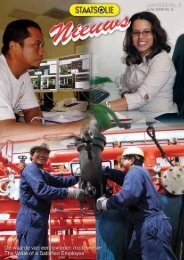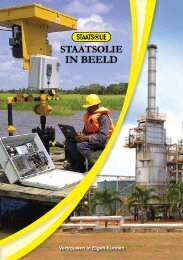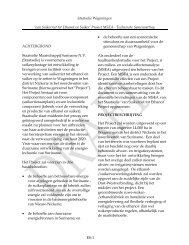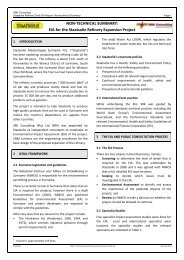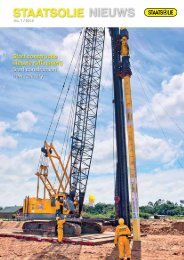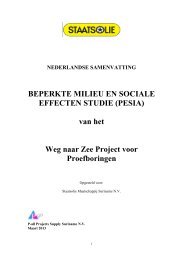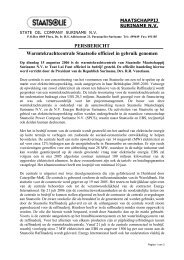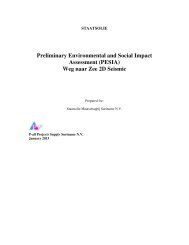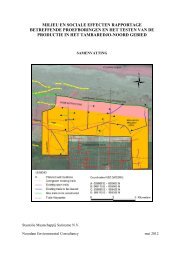concept EIA-rapport - Staatsolie
concept EIA-rapport - Staatsolie
concept EIA-rapport - Staatsolie
Create successful ePaper yourself
Turn your PDF publications into a flip-book with our unique Google optimized e-Paper software.
SRK Consulting: Project No: 439414 <strong>Staatsolie</strong> Pipeline <strong>EIA</strong> – Draft <strong>EIA</strong> Report Page 27<br />
The sediment load of the Suriname River from terrestrial runoff used to be relatively low at an<br />
estimated 250 000 tons per year (NEDECO 1968). It has further decreased since the construction of<br />
the Afobaka Dam in 1964, which created the Brokopondo Reservoir (officially known as the Prof. Dr.<br />
Ir. W.J. van Blommesteinmeer) and traps most of the upriver sediments. The current supply of<br />
terrestrial sediment to the estuary consists mostly of fine sediments transported as suspended load.<br />
Sand is found upriver of the study area, south of Paranam, where it occurs as sand banks. All river<br />
sediments in the area are of Holocene age.<br />
The record of a drinking water well at Peperpot (in Meerzorg, opposite the <strong>Staatsolie</strong> refinery) shows<br />
a 33 m thick clay layer, overlying alternating layers of coarse sand and clay. The clay in the upper<br />
33 m ranges between soft and firm, with the firm material located at a depth of between 12 and 21 m<br />
(SWM, unpublished data). Figure 4-4 shows an example of a half ripe (in between soft and firm) clay<br />
of the upper 1-2 m of the river bottom in front of the refinery.<br />
Figure 4-4: Suriname River clay bottom sediment taken nearshore at the <strong>Staatsolie</strong> refinery<br />
Source: Dirk Noordam (2012)<br />
4.1.2.2 Geomorphology<br />
Four major geographical zones can be distinguished in Suriname, shown in Figure 4-5:<br />
1. The Holocene Young Coastal Plain formed on sandy and clayey marine deposits. This plain is<br />
flat to nearly flat and very low-lying. It is characterized by extensive wetlands;<br />
2. The Pleistocene Old Coastal Plain, like the Young Coastal Plain, formed on sandy and clayey<br />
marine deposits. This plain is low-lying and flat to very gently undulating. The plain is alternating<br />
with deep swamps of the Early Holocene Mara Formation;<br />
3. The Zanderij or Savanna Belt formed on Late Tertiary braided river deposits. This belt forms an<br />
undulating to rolling lowland plateau, which is characterized by localized patches of savanna;<br />
and<br />
4. The Precambrian Guiana Shield area, commonly also known as the Interior.<br />
REUT/DALC 439414_<strong>Staatsolie</strong>Pipeline<strong>EIA</strong>_Draft <strong>EIA</strong> Report_Final June 2012




